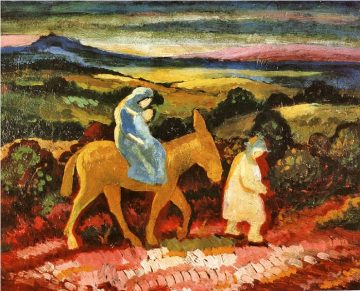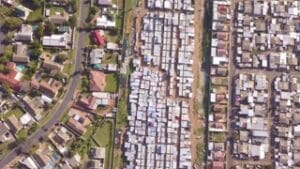
Following the appearance of the Wise Men in Israel, King Herod decreed that all male children under the age of two must be killed. Prior to this directive, Jesus’ adoptive father, Joseph, had been warned by an angel to flee Israel with Mary and the young boy Jesus. The Holy Family thus became immigrants, walking southward through the rocky terrain of Palestine until they reached the land of Egypt.While the scriptural canon provides no concrete details regarding the journey or the family’s stay in this foreign land, one can imagine the privation, hardship, and uncertainty that must have accompanied such an undertaking. Mary, herself still an adolescent, and Joseph, her young husband, likely sorrowed over the extended separation from their families, friends, and familiar food and customs. As they appear to have left Israel with little notice, they were probably unable to make plans for earning a livelihood, obtaining housing, or other necessities of life. I like to imagine our Heavenly Parents guiding Mary and Joseph through the Holy Spirit, illuminating their minds as to where they could safely camp for the night, how to make their limited rations stretch until Joseph could begin his own planting or start working for another household, and whom they should approach for assistance in the interim.
Although it is not known how long the young family remained in Egypt, it is reasonable to conjecture that Jesus’ childhood experience as a refugee in a foreign land informed his great sermon on charity:
“For I was an hungered, and ye gave me meat: I was thirsty, and ye gave me drink: I was a stranger, and ye took me in. . . .Then shall the righteous answer him, saying, Lord, when saw we thee an hungered, and fed thee? Or thirsty, and gave thee drink? When saw we thee a stranger, and took thee in? . . . Verily I say unto you, Inasmuch as ye have done it unto one of the least of these my brethren, ye have done it unto me.” (St. Matthew 25: 35-40)
It is my belief that, like the Holy Family, God at times inspires women and men to migrate to other nations so that they might fulfill God’s purposes in those lands. With anti-immigrant sentiment in the U.S. at an all-time high, perhaps as we approach this Christmas season we might all take a moment or two to reflect on the experience of not only the Baby Jesus, but the Immigrant Jesus, as well.






9 Responses
What a great thought. Thanks for sharing this.
I’ve never thought about this aspect of the Savior’s life before. It’s really given me something to ponder, and I appreciate that.
Beautiful post.
Immigrants yes, but unless they fell victim to robbers they probably didn’t have it too hard – remember that they have at least “gold, frankincense and myrrh”, and probably a bunch more stuff to pawn.
I love this too, Maria.
It reminds me of an article I read a few years ago. There was a push by some Catholic priests to talk about Jesus as an outsider, an “Other”, since most of his ministry took place outside his hometown. It was a neat take on him, and comforting also to modern day immigrants. Wish I could find that article…
Thanks, Maria. I remember class discussions about the reactionary Immigration Quotas of yesteryear, of “no Irish Need Apply” and the turning around of the St. Louis. It seemed like part of a darker, but distant, past. But the anti-immigrant rhetoric of the last several months (it is getting more strident, right — the language wasn’t this ugly even a very few years ago . . . . I mean, has anyone seen the Tancredo ads?)
Anyway, this is an aspect of the Christmas story I haven’t given much thought to . . . and it’s nice to, this year, in this world.
[…] Mary experienced the pain of being apart from her family as a young mother – an immigrant. […]
this post is cool.
On second thought, I’m still conflicted about the multi-complexities of immigration, partly due to my own experience of being ‘colonized’ by ‘immigrants’ who arrived in my own country and stayed there (the U.S. occupies my Pacific Island nation and renamed it, American Samoa).
Additionally, I live in what is ‘originally’ Native Lakota lands (now called Nebraska, South Dakota, generally the MidWest, etc.) and this idea of ‘immigrants’ has been heightened in not-so-sweet directions. For example, I am no longer excited to live near Mt. Rushmore – gee, whatta perfect waste of the sacred He Sapa/Paha Sapa (a.k.a. the Black Hills), yet used by a past full ‘immigrants’ to assert a propaganda of a tyrant nation (yes, the same one we currently live in, in which earlier on boldly attempted the extermination of Native Americans).
It’s so ugly, I can’t continue this thread.